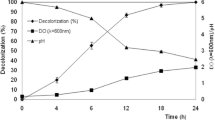Abstract
In this study, aerobic decolorization and degradation of azo dye Acid Orange G (AOG) by both suspended growing cells and immobilized cells of a yeast strain Candida tropicalis TL-F1 were studied. The effects of different parameters on decolorization of AOG by both growing suspended and immobilized strain TL-F1 were investigated. Furthermore, a possible decolorization mechanism of AOG was proposed through analyzing metabolic intermediates using UV–vis and high-performance liquid chromatography-mass spectrometry (HPLC-MS) methods. Strain TL-F1 could decolorize AOG in both liquid and solid mediums through degradation. The optimal conditions for decolorization with suspended growing cells of strain TL-F1 were as follows: 6–10 g/L sucrose, 5–7 g/L urea, ≥6 % (v/v) inoculation size, ≥160 rpm, 35–40 °C, and pH 5.0–6.0; and those for immobilized cells, the conditions were as follows: 4–6 g/L glucose, 0.2–0.4 g/L urea, 6–10 g/L (wet cell pellets) inoculation size, ≥160 rpm, 35–40 °C, and pH 5.0–7.0. Results of UV–vis scanning spectra suggested that AOG was decolorized through biodegradation, and the possible pathway was proposed through the results of HPLC-MS analysis and related literature. This is a systematic research on aerobic decolorization and degradation of AOG by both suspended and immobilized cells of a C. tropicalis strain.










Similar content being viewed by others
References
Tony, B. D., et al. (2009). International Biodeterioration and Biodegradation, 63, 462–469.
Deng, D. Y., et al. (2008). International Biodeterioration and Biodegradation, 62, 263–269.
Pearce, C. I., et al. (2003). Dyes and Pigments, 58, 179–196.
García-Montaño, J., et al. (2006). Journal of Hazardous Materials, 138, 218–225.
Mezohegyi, G., et al. (2012). Journal of Environmental Management, 102, 148–164.
Tan, L., et al. (2013). Bioresource Technology, 138, 307–313.
Miranda, R. C. (2013). Bioresource Technology, 142, 361–367.
Qu, Y., et al. (2010). Bioresource Technology, 101, 8016–8023.
Cajthaml, T., et al. (2008). Folia Microbiologica (Praha), 53, 289–294.
Kalmiş, E., et al. (2008). Canadian Journal of Microbiology, 54, 366–370.
Gou, M., et al. (2009). Journal of Hazardous Materials, 170, 314–319.
Arora, S., et al. (2011). Water Science and Technology, 63, 761–768.
Qu, Y., et al. (2012). Journal of Hazardous Materials, 223–224, 31–38.
Li, C., et al. (2013). Bioresource Technology, 131, 390–396.
Rodríguez-Couto, S. (2009). Biotechnology Advances, 27, 227–235.
Daâssi, D., et al. (2013). Journal of Environmental Management, 129, 324–332.
Thongchul, N., & Yang, S. T. (2003). Fermentation Biotechnology, 862, 36–51.
Bai, X., et al. (2010). Process Biochemistry, 45, 60–66.
Zhang, E., et al. (2008). Bioresource Technology, 99, 3787–3793.
Saratale, R. G., et al. (2009). Bioresource Technology, 100, 3897–3905.
Yang, Q., et al. (2003). Biotechnological Letters, 25, 709–713.
Tan, L., et al. (2009). Bioresource Technology, 100, 3003–3009.
Adav, S. S., et al. (2007). Biotechnology and Bioengineering, 96, 844–852.
Tiwari, S., et al. (2012). BMC Biotechnology, 12, 30.
Tuttolomondo, M. V., et al. (2014). Journal of Environmental Chemical Engineering, 2, 131–136.
Moreno-Garrido, I. (2008). Bioresource Technology, 99, 3949–3964.
Buitrón, G., et al. (2004). Bioresource Technology, 92, 143–149.
Davies, L. C., et al. (2006). Water Research, 40, 2055–2063.
Gomi, N., et al. (2011). Biodegradation, 22, 1239–1245.
dos Santos, A. B., et al. (2007). Bioresource Technology, 98, 2369–2385.
Hong, Y., et al. (2007). Applied Microbiology and Biotechnology, 75, 647–654.
Xu, M., et al. (2007). Applied Microbiology and Biotechnology, 76, 719–726.
Bomhard, E. M., & Herbold, B. A. (2005). Critical Reviews in Toxicology, 35, 783–835.
Huang, Y. C., et al. (2011). Toxicology in Vitro, 25, 1630–1637.
Acknowledgments
The work was financially supported by the National Natural Science Foundation of China (No. 51108223) and the Science and Technology Research Projects of Liaoning Provincial Education Department (No. L2013415).
Author information
Authors and Affiliations
Corresponding author
Rights and permissions
About this article
Cite this article
Tan, L., Li, H., Ning, S. et al. Aerobic Decolorization and Degradation of Acid Orange G (AOG) by Suspended Growing Cells and Immobilized Cells of a Yeast Strain Candida tropicalis TL-F1. Appl Biochem Biotechnol 174, 1651–1667 (2014). https://doi.org/10.1007/s12010-014-1086-9
Received:
Accepted:
Published:
Issue Date:
DOI: https://doi.org/10.1007/s12010-014-1086-9




